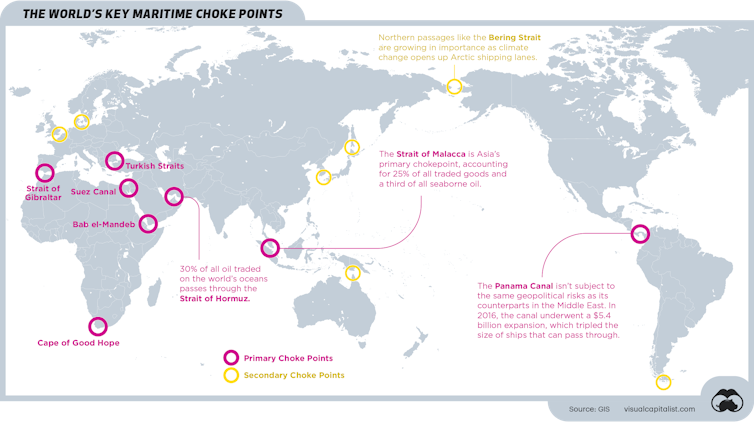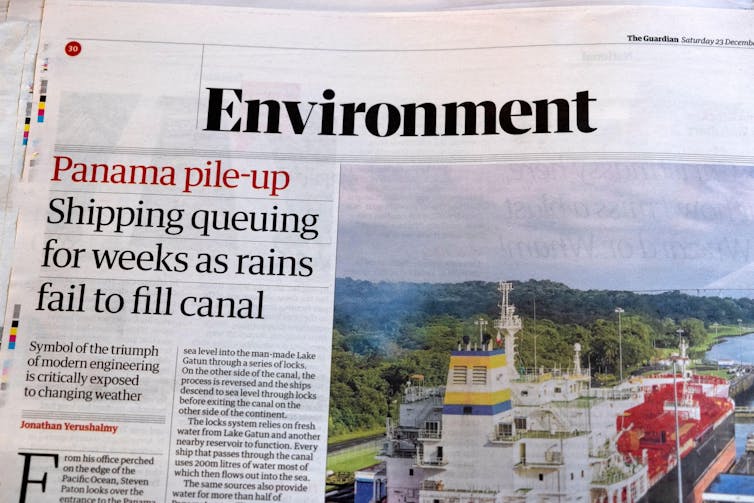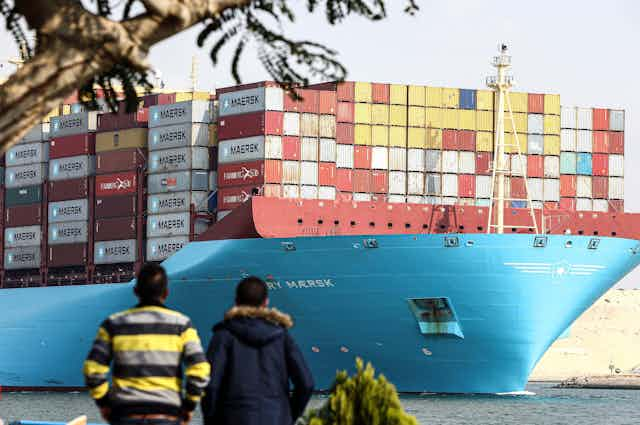The air strikes against targets in Yemen by the US and UK military have not been without criticism. They aim to keep the Houthis from attacking merchant vessels in the Bab el-Mandeb strait. Less than 30 ships have been attacked by Houthis since they seized the Israeli-linked Galaxy Leader vessel in November. It’s a relatively small number, compared to the thousands of ships that have passed through the area since.
Unlike the 2021 Suez Canal blockage, traffic is still moving along the shortcut between Asia and Europe. While it adds one to two weeks of travel time and around US$1 million (£786,000) in cost, ships can also go around Africa.
In response, container prices have increased sharply, but are not at the levels reached at the height of the COVID-19 pandemic. Even if the path through the Red Sea to the Suez Canal becomes unusable, this is hardly unprecedented. The Suez Canal was closed due to war from 1967 to 1975.
But the reasons for the strikes carried out to protect global trade are likely to lie deeper than this. Global supply chains have become a lot more important for everyday life since the 1970s, so the impact of disruptions in the Red Sea is now much bigger. Also, crucially, Bab el-Mandeb is only one of several maritime choke points that are vital for world trade.

Transport choke points
Choke points are narrow parts of main trade lanes, usually straits or canals. As the geopolitical weaponisation of supply chains increasingly becomes a part of economic statecraft, their vulnerability grows. As the Houthis have shown, disrupting global trade at one of these choke points, does not require huge military power.
Disabling the biggest choke points could have severe global consequences. While about 12% of global trade passes the Suez Canal, more than twice as much goes through the Malacca Strait between Indonesia and Malaysia. The Malacca Strait regularly has issues with piracy.
Disruptions at choke points potentially have much larger effects around the world, as they affect traffic going to and from many countries. Alternative routes to them are difficult, if not impossible, to find. This was maybe most impressively demonstrated by the 2021 Suez blockage when a container ship was wedged across the canal and held up US$9.6 billion in trade per day for nearly a week.
Today is not 2021. Ships continue to use the Suez Canal and the Red Sea is not closed to shipping, the volume of shipping containers passing through Suez fell drastically from 500,000 per day in November 2023 to 200,000 per day in December 2023. Demand is not nearly as high as it was back then. Indeed, there has been over-capacity on many shipping routes over the past year. This can now serve as a buffer when vessels spend more time on longer routes.
Running out of routes
But another of the main choke points is currently suffering severe disruptions. The Panama Canal, which connects the Atlantic and Pacific, is experiencing an intense drought. Now water levels in the Panama Canal are so low that shipping capacity is severely limited. Shipping giant Maersk recently shifted cargo to the railway line running in parallel to the canal. Before the current crisis, some ships took a ten-day detour on their journeys between Asia and the US east coast by going through the Suez Canal.

Alternatives for the route through the Bab el-Mandeb and the Suez Canal are limited. The Panama Canal is not a viable option at the moment. The Northern Sea Route is 40% shorter than the alternative via the Suez Canal for connecting Asia to Europe. But ice makes it navigable for no more than five months per year and there are concerns about the impact of ships on the fragile Arctic ecosystem.
The railway line linking China to Europe has seen significant growth in freight transport in recent years. But both rail and Northern Sea Route connection are affected by sanctions on Russia. What is left for most who are keen to avoid the Red Sea is the long detour around Africa.
Strait of Hormuz
The original military mission in the Red Sea was aptly called “Operation Prosperity Guardian”. Countries involved in the White House’s announcement regarding the strikes on Yemen include major exporters such as Germany and South Korea, Denmark, the home of affected shipping line Maersk and others, as well as countries such as Australia and Canada. This is an indication of the profound global effects this disruption is having. After Houthi attacks continued despite warnings, the military actions have sent a signal that free navigation will be protected despite the high cost.
They can also be understood as a signal that countries are ready to defend other choke points. The most likely target for this is what a former chief economist of the Organisation for Economic Co-operation and Development (OECD) called called “a horrible and inevitable progression that could see the situation in the Red Sea spread to the strait of Hormuz”.
At least one-fifth of global oil and gas transports is shipped through the 39km wide stretch of sea between Oman and Iran. Iran backs the Houthis in Yemen, as well as other groups in the Middle East. The Strait of Hormuz has a long history of tensions. By blocking this choke point, Iran could throw the global economy into serious disarray.
However, experts also highlight the likelihood of a severe global backlash to any such action – doing more harm to Iran than good. The justification for the current military actions against the Houthis is likely to also contain a nod to this.

